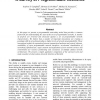Free Online Productivity Tools
i2Speak
i2Symbol
i2OCR
iTex2Img
iWeb2Print
iWeb2Shot
i2Type
iPdf2Split
iPdf2Merge
i2Bopomofo
i2Arabic
i2Style
i2Image
i2PDF
iLatex2Rtf
Sci2ools
DAGSTUHL
2001
2001
Programmable Networks
In this paper we present a programmable networking model that provides a common framework for understanding the state-of-the-art in programmable networks. A number of projects are reviewed and discussed against a set of programmable network characteristics. We believe that a number of important innovations are creating a paradigm shift in networking leading to higher levels of network programmability. These innovations include the separation between transmission hardware and control software, availability of open programmable network interfaces, accelerated virtualization of networking infrastructure, rapid creation and deployment of new network services and environments for resource partitioning and coexistence of multiple distinct network architectures. We present a simple qualitative comparison of the surveyed work and make a number of observations about the direction of the field.
DAGSTUHL 2001 | DAGSTUHL 2007 | Programmable Network | Programmable Network Characteristics | Programmable Networking Model |
Related Content
| Added | 31 Oct 2010 |
| Updated | 31 Oct 2010 |
| Type | Conference |
| Year | 2001 |
| Where | DAGSTUHL |
| Authors | Andrew T. Campbell, Michael E. Kounavis, John B. Vicente |
Comments (0)

